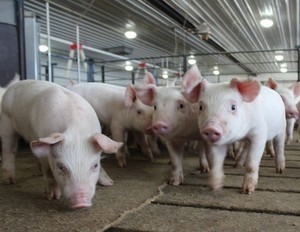FDA in bid to support nano-sized feed innovation

Last week saw the US Food and Drug Administration (FDA) release draft guidance on the use of nanotechnology in livestock diets.
The FDA told us the recommendations take into account the latest scientific information available.
"As the field of nanotechnology advances, we anticipate that manufacturers will likely want to use nanomaterials in food for animals and, by issuing this draft guidance, FDA wants to help them identify and understand potential issues related to the safety and regulatory status of food for animals containing nanomaterials or otherwise involving the application of nanotechnology," said Jeff Ventura, a communications spokesperson for the regulator.
Research and development on nanoscale-science (particles of 1-100 nanometer) has been growing worldwide but there are relatively few commercialized applications.
Nanosized additives already produced or currently under development for animal feed include nanomaterials that can bind and remove toxins or pathogens or ones that can improve nutrient uptake.
“We are taking a prudent scientific approach to assess each product on its own merits and are not making broad, general assumptions about the safety of nanotechnology products," said FDA Commissioner Margaret Hamburg.
Pre-consultation with FDA
Feed additive makers and pharmaceutical companies are encouraged to consult with the FDA early on in the product development process “so that a determination can be made as to whether your animal food product involves the application of nanotechnology and so that any questions related to safety and regulatory status can be appropriately addressed.”
The agency cautions that materials manipulated on the nanoscale level through the use of nanotechnology may have different biodistribution, biocompatibility, or toxicity than that seen in the larger-scale version:
“Two animal food ingredients of the same chemical composition, but of different particle size, shape, or other morphological feature, may exhibit different physicochemical properties. For example, some tea polyphenols are anti-oxidants in their bulk form, but the same tea polyphenols are pro-oxidants in their nanoscale form."
The FDA is seeking industry comment on the draft guidelines from now until mid-September.
Feed nanomaterial research
A study in Livestock Science in March this year indicated that supplementation of the diets of pigs with chromium-loaded chitosan nanoparticles had beneficial effects on growth, carcass characteristics, and pork quality, and positively affected lipid catabolism in finishing pigs.
And research published in the December 2012 edition of the journal, Biological Trace Element Research, showed nano-selenium (NS) in sheep diets improved ruminal fermentation and feed conversion efficiency.
Antibiotic alternatives
Nanoparticles in feed could provide an alternative to non-therapeutic uses of antibiotics such as tetracyclines, penicillin, macrolides, and lincomycin in poultry production, said Professor Jennifer Kuzma, in a 2010 meta-analysis of nanotechnology applications in animal production in Livestock Science.
She referenced a research project looking at the use of a polystyrene (PS) base, polyethylene gycol (PEG) linker, and mannose targeting-biomolecule to bind the pathogens in the gut of livestock to prevent colonization and growth.
Health risks of PS-PEG nanoparticles, noted Kuzma, have been previously investigated and in one toxicological study with mannose-linked PS-PEG nanoparticles, low level toxic effects to human colon fibroblasts were observed.
However, overall, PEG has a low degree of immunogenicity and antigenicity and is essentially chemically inert, and no effects were observed for other cell types and tissues, she said.
She advocates the need for more detailed studies to determine if and where the particles accumulate in animal tissue, the impacts on meat and poultry products, and environmental exposure and effects from animal wastes containing the particles.
Feed contaminant detection
Kuzma, based at the Humphrey Institute of Public Affairs in the US, also reviewed research involving the use of nanoparticles for rapid identification of foreign compounds in feed.
Europium nanoparticles are used to detect enzymes, such as hydrolases and epoxidases that degrade foreign, toxic compounds common in feed.
Europium emits light at a very specific wavelength when excited and improves the sensitivity of biochemical assays, and could be used to develop rapid assays at higher sensitivity, lower cost and improved ease of use, said the researcher.














